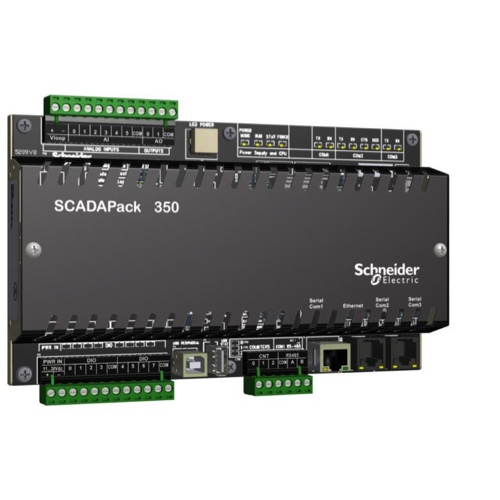SCADAPack 350

SCADAPack™ Smart RTUs combine the communication and monitoring capabilities of an RTU with the processing and data-logging power of a PLC. They are ideal for remote processes that require automatic supervision and autonomous control. They are designed for the harsh conditions associated with remote sites in applications such as oil and gas and water and wastewater facilities.
SCADAPack™ 350 is designed with a 5209 controller board, an integrated power supply, serial communications, digital and analog I/O, 10/100 Mb/s Ethernet, 12 Mb/s USB A and USB B ports and turbine flow meter counter inputs. Power saving features include Sleep Mode, 24V-power shutdown, Ethernet port shutdown, SCADAPack Vision power down, communication port power control, USB disable and a reduced power mode that lowers the CPU clock. Application programs can be written in Relay Ladder Logic, C language and IEC 61131-3. The I/O capacity of the SCADAPack 350 can be expanded using 5000 I/O modules and a maximum of twenty can be used. This controller board can be combined with a 5606 Integrated I/O module, forming a SCADAPack 357.
SCADA: Learning the Basics
Supervisory Control and Data Acquisition (SCADA) systems are a combination of both hardware and software that allows monitoring of various devices that provide information about specific environments or processes. This information is transmitted through logic controllers, or other smart devices, and is sent to software interfaces known as an HMI, where the information is displayed in a way that individuals can read and interpret the data. SCADA is not only used for monitoring, it is also used for control. Through SCADA, it is possible to manipulate, move, or change the state of certain devices on the network. For example, it is possible to initiate a command through the HMI software that will energize or de-energize a solenoid valve, thus changing its state. In most scenarios, there are dozens, hundreds, or even thousands of points throughout a location or multiple locations that are being monitored and controlled through SCADA. SCADA systems can be found in many different industries such as telecommunications, water and wastewater, energy, oil and gas refining and transportation. These systems can be used to monitor and control only a few simple points, or can be used in massive energy plants where tens of thousands of data points are being interpreted and controlled every minute.
Hardware used in SCADA systems include:
- PLCs, which can act as a bridge between the hardware and software, as well as providing data transmission and network communications.
- Field monitoring and control devices, such as limit switches, temperature transmitters, pressure transmitters, solenoid valves, chemical monitoring devices and motor starters.
Software used in SCADA systems include:
- HMI or Human Machine Interface software receives data throughout the system and organizes it in a way that can be easily interpreted. It can also provide control based on the information it receives.

